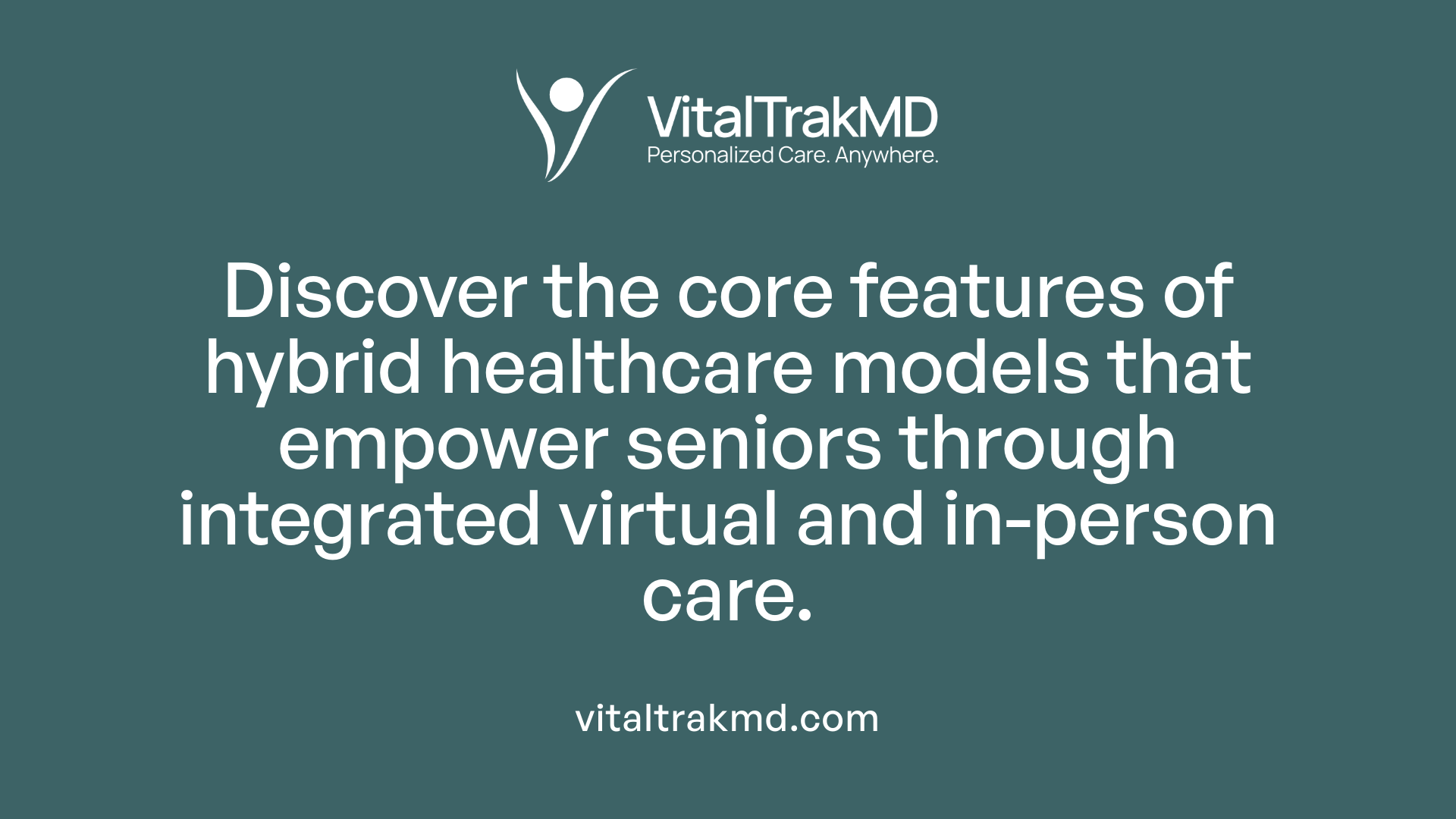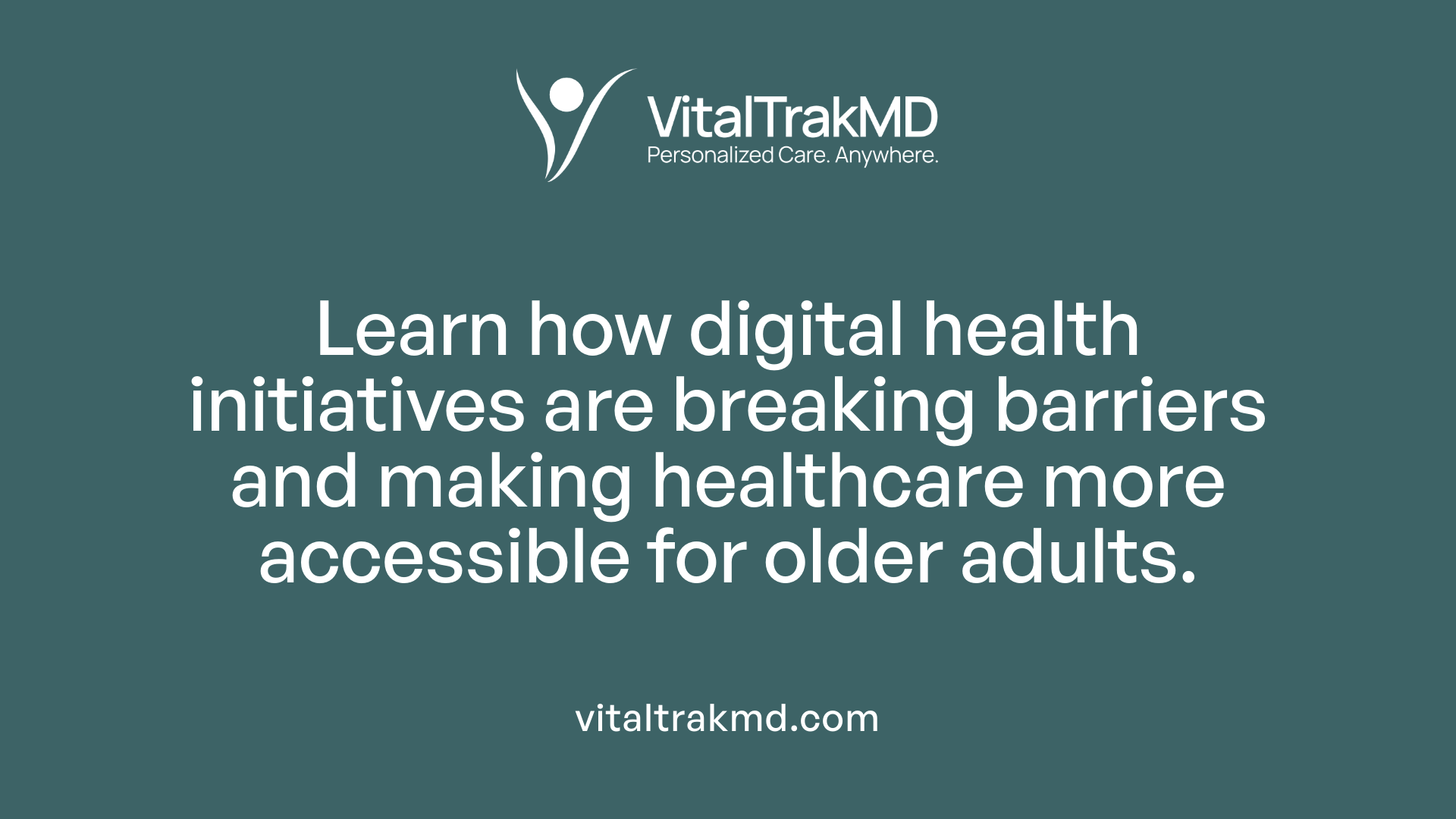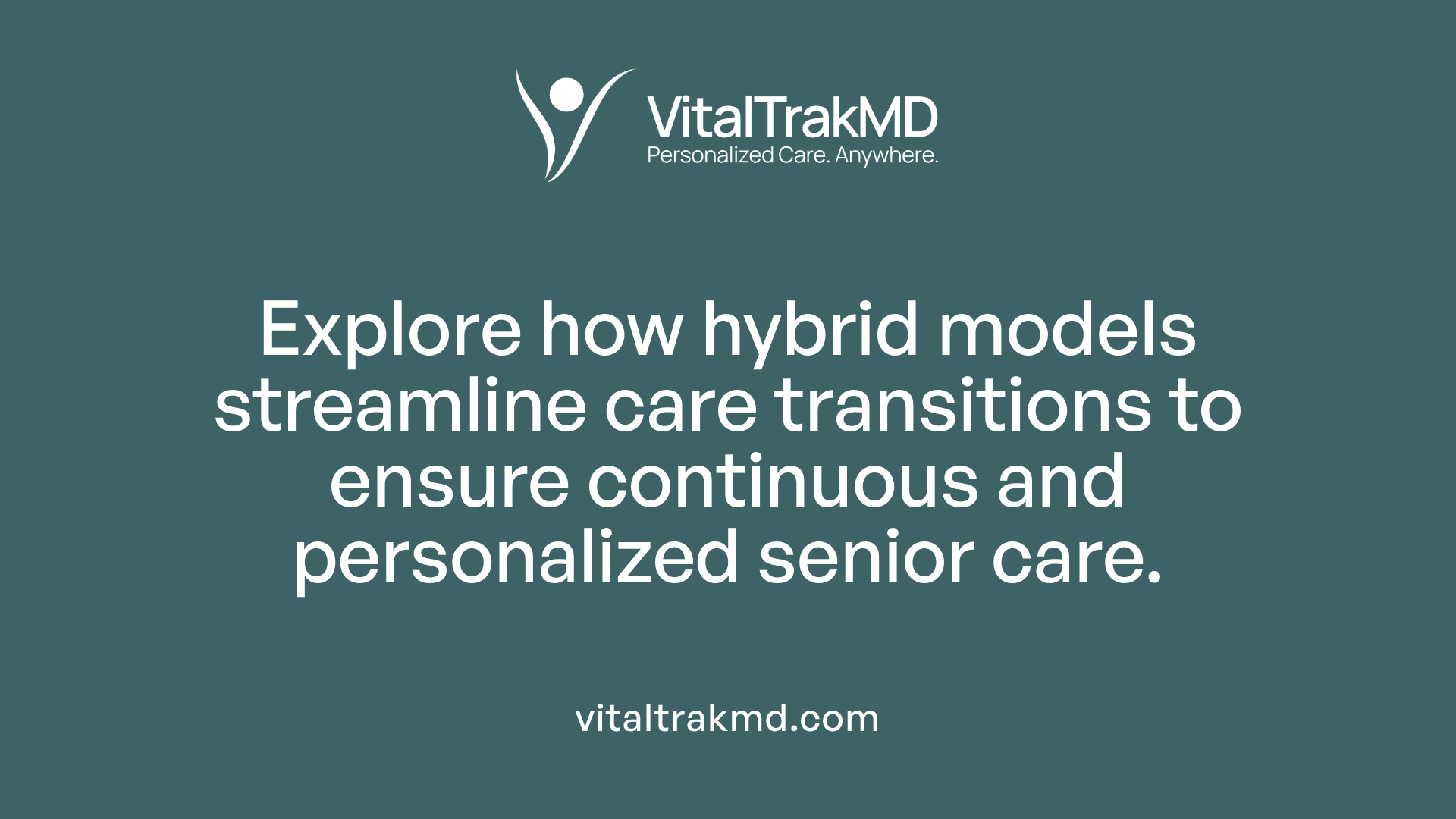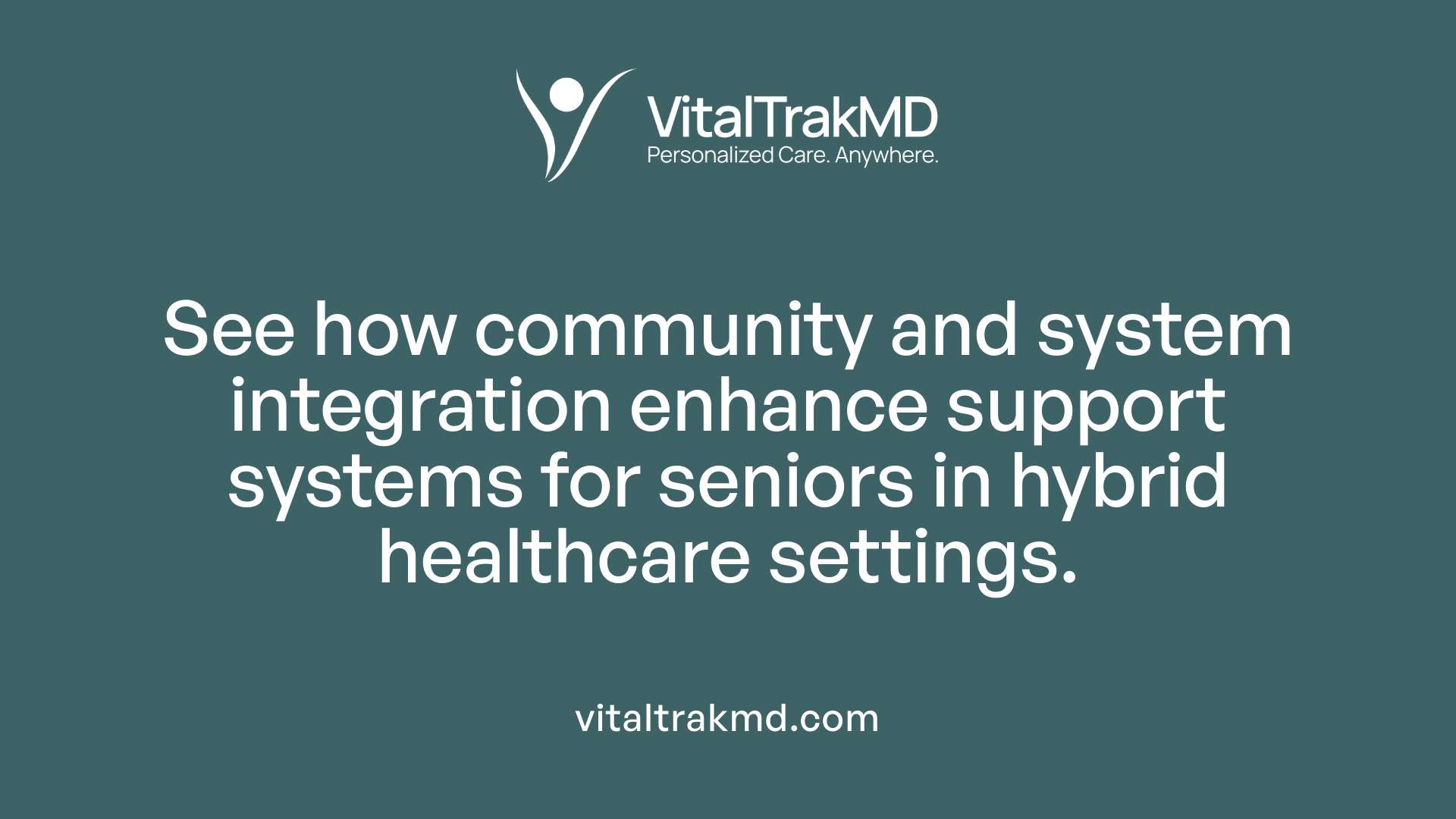Navigating Senior Support Programs in Hybrid Healthcare Systems

Introduction to Hybrid Healthcare and Senior Support
The integration of digital and traditional care modalities has revolutionized healthcare delivery, especially for aging populations. Hybrid healthcare models, combining in-person and virtual services, are at the forefront of this shift, addressing longstanding barriers such as mobility, geographic isolation, and resource limitations. As the global demographic shifts toward older populations, understanding how these hybrid systems function and support seniors is crucial to enhancing care quality, accessibility, and continuity across diverse settings.
Key Features of Hybrid Healthcare Models Supporting Seniors

What are the key features of a hybrid healthcare model supporting seniors?
Hybrid healthcare models blend physical and virtual care to better serve older adults. They incorporate remote health services like telehealth consultations, remote monitoring devices such as sensors and ECGs, and virtual hospital-like programs like Sheba Beyond in Israel. These features make it easier for seniors to receive continual care without frequent visits to healthcare facilities.
One important aspect is promoting aging-in-place. Virtual programs allow seniors, especially those with chronic diseases or mobility challenges, to stay safely at home while still accessing necessary medical attention. This approach helps reduce the need for hospitalization, lowers healthcare costs, and enhances quality of life.
Care coordination is vital in hybrid models. Customized pathways and support services ensure each senior’s needs are met, addressing disparities related to race, ethnicity, or geographic location. For example, programs that use telehealth and remote monitoring can bridge gaps for older adults in nonmetropolitan areas or from minority groups.
Flexibility is another feature, allowing healthcare providers to tailor services based on patient circumstances. Some patients may still prefer in-person visits, while others benefit from fully virtual interactions. This adaptability supports better health outcomes, improved patient satisfaction, and more efficient resource use.
Overall, hybrid healthcare models aim to increase access, improve safety, and ensure continuous, personalized care for seniors—whether through digital platforms, in-home support, or a combination of both.
Enhancing Access for Seniors via Digital Health Initiatives

In what ways do digital health initiatives improve access to care for seniors in hybrid healthcare settings?
Digital health initiatives such as telemedicine and remote monitoring technology play a pivotal role in increasing healthcare accessibility for older adults. During the COVID-19 pandemic, these tools allowed seniors to bypass obstacles related to geography, mobility, and transportation, which are common challenges for this population.
Hybrid healthcare models merge in-person visits with virtual services, ensuring that seniors can receive timely medical attention from their homes. This flexibility is especially beneficial for those living in underserved or rural areas where healthcare facilities may be scarce or difficult to reach.
Furthermore, these digital solutions help bridge disparities among racial and ethnic minority seniors. By providing flexible access options and accommodating sensory or mobility impairments, they promote equitable healthcare experiences.
Remote monitoring devices—such as sensors, ECGs, portable X-ray systems, and platforms like Datos Health—enable continuous health assessment, leading to early intervention and reduced hospital visits. These tools also facilitate the identification of social determinants of health, such as social isolation or food insecurity, that may otherwise be overlooked.
Overall, integrating digital health within hybrid care creates an inclusive, accessible environment. It supports older adults in managing chronic conditions, enhances safety, and helps providers deliver more personalized, comprehensive care tailored to diverse needs.
Facilitating Care Transitions through Hybrid Strategies

How do hybrid healthcare systems facilitate care coordination and transitions for seniors?
Hybrid healthcare models combine physical and virtual care delivery methods to create a seamless experience for seniors navigating their health journeys. These systems incorporate remote monitoring technologies such as sensors, portable examination kits, and telehealth platforms, allowing continuous assessment of patients’ health status without frequent hospital visits.
During transitions between different levels of care—like from hospital to home or between outpatient appointments—hybrid models provide stable and integrated pathways. For example, remote patient monitoring systems enable healthcare providers to track vital signs and recognize early signs of deterioration, ensuring timely interventions.
The COVID-19 pandemic highlighted the versatility of these models. They proved essential in managing hospital capacities by supporting remote home hospitalization, reducing the need for physical beds, and minimizing exposure risks.
Furthermore, hybrid approaches improve access to specialist care, especially for seniors with limited mobility or those living in rural areas. This helps maintain continuity of care, supports aging-in-place, and minimizes unnecessary hospital admissions.
By leveraging digital tools and coordinated communication channels, hybrid systems facilitate efficient, personalized, and safe transitions for seniors. They also help reduce healthcare costs by preventing avoidable hospital stays and fostering proactive care management.
Policy and Organizational Frameworks Shaping Senior Support
What policy and organizational frameworks influence the development of senior support in hybrid healthcare models?
Developing effective support systems for seniors within hybrid healthcare models depends heavily on a mix of policies, regulations, and organizational strategies. Regulations around telehealth, including licensure, reimbursement, and data privacy laws, set the foundation for safe and widespread virtual care.
Funding policies also play a critical role by allocating resources for integrated health and social services, encouraging innovative models such as remote monitoring and community-based care programs. Governments and agencies promote age-friendly environments through initiatives that support accessible housing, public spaces, and workplaces that embrace aging populations.
On organizational levels, evidence-based models like the Omaha System guide care coordination focusing on comprehensive, person-centered interventions. Implementation frameworks, such as ERIC (Expert Recommendations for Implementing Change) and RE-AIM (Reach, Effectiveness, Adoption, Implementation, Maintenance), help tailor programs to ensure they are sustainable, scalable, and effective.
These policies and organizational efforts synergize to foster a holistic, accessible, and patient-centered approach to care. They facilitate creating environments where older adults can thrive, leveraging technology and community resources harmoniously. Ultimately, they shape a supportive infrastructure that promotes health, independence, and well-being for aging populations within hybrid healthcare settings.
Benefits and Challenges of Integrating Senior Support in Hybrid Systems
What are the benefits and challenges of integrating senior support programs within hybrid healthcare models?
Incorporating programs that support older adults into hybrid healthcare systems can greatly improve their access to medical services. This approach helps overcome common barriers such as travel difficulties, especially for those in rural or underserved areas. It ensures continuity of care by combining in-person visits with telehealth, making it easier to manage chronic illnesses and respond promptly to health concerns.
Furthermore, hybrid models can help reduce disparities, offering more equitable access regardless of race, ethnicity, or geographic location. They also increase patient satisfaction by providing flexible care options and can improve healthcare workforce efficiency and retention.
However, implementing these models has its hurdles. Technological barriers are significant; some seniors lack reliable internet, digital devices, or have limited digital literacy, which can prevent active engagement. Privacy and data security concerns must be addressed to maintain trust and compliance.
Successfully deploying hybrid care for seniors requires investing in user-friendly platforms, providing targeted training for both healthcare providers and patients, and tailoring workflows to meet their needs. Ensuring that technology enhances accessibility without adding complexity is crucial. With strategic planning, hybrid systems can deliver more inclusive, effective, and patient-centered care for older adults.
Community Supports and System-Wide Integration for Elderly Care

How do community supports and system-wide integration enhance senior care within hybrid healthcare models?
Community supports and broad health system coordination play a crucial role in elevating elderly care, especially within hybrid models that combine virtual and physical healthcare services. These approaches facilitate resource sharing among healthcare providers, social services, and community organizations, creating a more comprehensive and accessible network of care.
Programs like the Health–Social Partnership Program exemplify the benefits of nurse-led case management supported by social services. Such initiatives boost seniors' confidence in managing their health, promoting better adherence to care plans and early detection of issues. This is particularly valuable in rural or underserved areas where access to traditional healthcare facilities may be limited.
Strong collaborations among hospitals, community groups, and social services help ensure seamless communication, reduce care fragmentation, and prevent unnecessary hospitalizations. For example, integrating home visits, telehealth consultations, and mobile clinics allows seniors to receive continuous, personalized care without frequent hospital trips.
Despite facing challenges such as staffing shortages and pandemic-related disruptions, these community-centered strategies promote aging in place and enhance the resilience of healthcare systems. They support tailored services that meet diverse needs, ensuring that elderly populations remain safe, supported, and connected within their communities.
| Aspect | Description | Impact |
|---|---|---|
| Resource sharing | Coordination between health and social services | Improves service efficiency and reduces duplication |
| Care management | Nurse-led case management programs | Enhances self-efficacy and early intervention |
| Outreach programs | Mobile clinics, telehealth, home visits | Expands access especially in rural areas |
| Challenges | Staffing shortages, pandemic barriers | Require innovative workforce and technology solutions |
| Benefits | Aging in place, reduced hospitalizations | Promotes independence and system sustainability |
Community supports and system-wide integration create a resilient, accessible framework for elderly care—embracing the realities of hybrid healthcare models to better serve older adults in diverse living environments.
Strategies for Effective Implementation of Senior Support in Hybrid Systems
What strategies can be employed to effectively implement senior support programs in hybrid healthcare systems?
Implementing senior support programs successfully in hybrid healthcare settings depends on multiple interconnected strategies. Central to these is the utilization of digital tools like remote monitoring devices and telecommunication platforms. These technologies enable older adults to access healthcare services conveniently from home, ensuring continuous care even during crises such as pandemics. Devices such as sensors, telehealth tablets, and remote patient monitoring systems can track health metrics, alert providers to issues, and coordinate care efficiently.
Building partnerships is also crucial. Collaborations with community groups, healthcare organizations, and NGOs create a network of support that fosters outreach and resource sharing. Programs involving community centers, intergenerational projects, and volunteer groups like retired IT professionals support digital literacy and peer mentoring, enhancing engagement and reducing social isolation.
Staff training forms another pillar. Equipping healthcare workers with digital literacy skills and knowledge of holistic, person-centered care prepares them to navigate hybrid models effectively. Training can include technology use, cultural competency, and ways to foster strong relationships with older adults.
Involvement of older adults and volunteers helps address digital barriers and promotes inclusivity. Volunteers can assist in technical support, social activities, and care coordination, fostering a community-oncology approach.
Policy measures are essential for broadening access and ensuring program sustainability. These should focus on making services equitable, incorporating contingency plans for emergencies, and addressing workforce shortages. Such policies can also incentivize innovation and cross-sector coordination.
Structured implementation frameworks, regular communication channels, and ongoing evaluation facilitate adaptation and improvement. Continual assessment allows programs to respond to evolving needs, technological advancements, and unforeseen challenges, ensuring resilience and effectiveness.
In summary, integrating digital technology, forging partnerships, training staff, engaging communities, and enacting supportive policies create a robust foundation for senior support in hybrid healthcare models. These strategies collectively bridge gaps, improve access, and promote health equity for older populations.
Supporting Aging-in-Place with Hybrid Healthcare Services

How can hybrid healthcare models support aging-in-place for seniors?
Hybrid healthcare models combine traditional in-person care with virtual and remote health services to help seniors live independently at home. They utilize digital health tools such as remote monitoring devices, telehealth platforms, and virtual consultations. This integration allows continuous oversight of health conditions and quick access to medical advice without leaving home.
Remote monitoring technologies like sensors, ECG, and portable imaging devices enable early detection of health issues, which can prevent hospital admissions and complications. Seniors can receive care during regular virtual check-ups, reducing the need for transportation and accommodating mobility challenges.
Furthermore, hybrid models foster stronger connections with healthcare providers, ensuring care is personalized and flexible. They also support safety with features like fall detection and emergency alerts, promoting a secure environment.
By aligning care with seniors' preferences to stay in their homes, these models enhance their sense of independence and community involvement. Overall, hybrid healthcare improves access, safety, and quality of life, making aging-in-place a practical and sustainable goal.
Emerging Trends and Innovations in Virtual Elder Care
What emerging trends and innovations are shaping virtual care models focused on seniors within hybrid healthcare systems?
Recent advances in virtual elder care are significantly transforming how healthcare providers support aging populations. One prominent trend is the use of AI-powered health monitoring tools, which continuously analyze data from sensors and wearable devices to detect early signs of health deterioration or cognitive decline. These intelligent systems enable proactive interventions, helping seniors stay healthy at home.
In addition, augmented reality (AR) and unobtrusive sensors are being integrated into care environments. These technologies provide real-time activity tracking and help monitor physical and mental well-being without intruding on daily life. For example, unobtrusive sensors can track movement patterns and detect falls or activity changes, reducing emergency risks.
Personalized virtual platforms like the Interactive Care Platform (I-Care) are tailored to meet individual needs. Developed with input from seniors and caregivers, these platforms facilitate better communication, medication management, and social engagement. They help address issues like social isolation and cognitive impairment by linking seniors with support networks and healthcare providers.
Efforts to simplify technology interfaces are crucial for widespread adoption. Tutorials, practice sessions, and user-friendly designs ensure that older adults can easily navigate and utilize these digital tools, increasing their comfort and confidence.
Overall, these innovations create more flexible, preventive, and tailored virtual care models. By integrating advanced technologies with user-centric designs, healthcare systems can better support seniors' independence, health, and well-being within hybrid care frameworks.
Enhancing Resource Accessibility and System Inclusivity
How can access to resources and system accessibility be enhanced for seniors within hybrid healthcare settings?
Improving resource access for seniors in hybrid healthcare involves multiple strategies. First, targeted digital literacy training helps older adults navigate telehealth platforms effectively, reducing frustration and increasing engagement. This can include community-based workshops and personalized coaching.
Expanding broadband infrastructure, especially in rural regions, is crucial. Collaborations between healthcare entities and telecommunications providers, as seen in various programs, help bridge the digital divide, ensuring reliable internet access for remote consultations and digital health services.
Designing user-friendly telehealth platforms is another vital step. Devices and interfaces tailored to seniors, with larger fonts, simplified menus, and voice commands, improve usability and safety during virtual visits.
Culturally and linguistically appropriate services, such as remote translation and interpreter services, promote inclusivity. These services help non-English-speaking seniors or those with specific cultural needs feel more comfortable and understood during virtual interactions.
Finally, supporting in-home care and resource navigation through digital companions, mobile health units, and virtual care coordinators ensures continuous health management. These efforts foster independence, reduce barriers to care, and facilitate seamless integration of physical and virtual services.
By combining technological improvements with community support, healthcare systems can create a more accessible, inclusive experience for all seniors navigating hybrid care models.
Conclusion: Charting the Future of Senior-Centric Hybrid Care
As healthcare continues to evolve, hybrid models stand out as a promising approach to address the complex needs of the aging population. By integrating technological innovation, community engagement, and evidence-based frameworks, these models not only improve access and continuity but also foster aging-in-place and health equity. Policymakers, healthcare providers, and community organizations must collaborate to overcome barriers, invest in workforce training, and develop inclusive policies that support sustainable, patient-centered senior care across diverse settings. Embracing these strategies promises a future where seniors enjoy improved health outcomes, enhanced quality of life, and the dignity of living independently within their communities.
References
- Designing for flexibility in hybrid care services - PubMed Central
- Comparing In-Person Only, Telemedicine Only, and Hybrid Health ...
- hybrid programming | Massachusetts Councils on Aging
- Bridging the Gaps: How Care Navigators Guide Seniors Through a ...
- Actualizing Better Health And Health Care For Older Adults
- Navigating Current Challenges in Healthcare Access for Elderly ...
- Navigating Through Innovation in Elderly's Health: A Scoping ...
Recent articles
Want to Feel Better and Live Healthier?
Join hundreds of patients taking control of their health with personalized care that fits their life – not the other way around.
Rated 4.8/5 by 32+ customers







